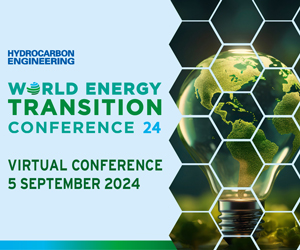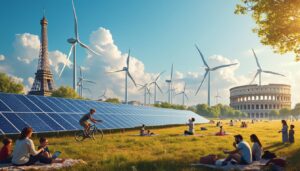Keeping an open mind remains a constant challenge.
In a landscape dominated by social networks and a continuous flow of information, it is easy to form fixed opinions.
As a bioenergy researcher, I have realized how crucial it is to reevaluate our biases in the face of new technologies.
When a wind farm like Fenner Wind Farm develops in our region, it raises legitimate questions among local residents and farmers. These renewable projects not only contribute to the state’s energy transition, but they also offer tangible benefits to host communities. For example, direct payments to local communities help fund essential infrastructure such as roads and parks. Moreover, these initiatives help preserve agricultural land by providing new sources of income for family farms, thus ensuring the sustainability of local agriculture for future generations.
What are the economic benefits of renewable energy projects in New York?
The adoption of renewable energy projects in New York is not limited to environmental preservation. These initiatives also bring significant economic benefits to local communities, businesses, and the state as a whole. By investing in clean energy sources like solar and wind, New York creates jobs, stimulates the local economy, and enhances its energy independence.
How do renewable projects create local jobs?
Renewable energy projects are powerful job-creation engines in the state of New York. The construction, installation, and maintenance of the necessary infrastructure require a diverse and skilled workforce. For example, the Morris Ridge solar farm, the largest solar farm in New York, generates direct and indirect jobs in the region. These job opportunities help reduce the unemployment rate and increase the standard of living for local residents.
Additionally, renewable projects encourage the development of new skills and vocational training, thus preparing the workforce to meet the future needs of the energy sector. Local businesses also benefit from the increased demand for services and materials, thereby stimulating the regional economy.
What are the direct financial impacts for local communities?
Investments in renewable energy bring direct funds to local communities. The companies that develop these projects, such as wind and solar farms, make direct payments to municipalities. For example, Morris Ridge Solar contributes approximately $1.6 million annually in direct payments to local communities. These funds can be reinvested in public infrastructure, education, healthcare, and other essential services.
Furthermore, renewable projects attract additional private investments, thereby fostering local economic growth. The revenues generated can also support community initiatives such as revitalizing public spaces, creating parks, and improving road infrastructure.
To what extent does the preservation of agricultural land benefit the economy?
The preservation of agricultural land is a crucial economic advantage of renewable energy projects in New York. Instead of seeing agricultural land transformed into residential or commercial zones, renewable projects help keep these spaces actively productive. For example, the establishment of wind farms on agricultural land provides an additional source of income for farmers without compromising their core operations.
This dual use of land ensures the continuity of farming operations, thus supporting families and future generations. Moreover, by preventing the loss of agricultural land, New York preserves its ability to produce food locally, thereby reducing reliance on imports and strengthening the state’s economic resilience.
What are the financial returns from tax agreements with private companies?
Tax agreements between private companies and local governments constitute another important source of revenue from renewable energy projects. These agreements allow municipalities to receive substantial funds from companies that install renewable infrastructure on their territory. For instance, public schools benefit from millions of dollars thanks to these agreements, thereby improving the quality of education and school facilities.
These funds are essential for financing community projects without raising local taxes. They also enable investments in environmental and social initiatives, thus strengthening the economic and social fabric of the affected areas.
How do renewable projects stimulate local commerce?
Renewable energy projects have a positive impact on local commerce by increasing the purchasing power of residents and attracting new customers to nearby businesses. During the construction and operation of solar and wind farms, workers spend their wages in local stores, stimulating the regional economy.
Furthermore, the presence of renewable projects can attract businesses and investors interested in a dynamic region committed to the energy transition. This creates a conducive environment for local business growth and innovation, thereby enhancing New York’s economic competitiveness.
What are the long-term financial benefits for the state of New York?
Investing in renewable energies ensures long-term reductions in energy costs and economic stability for the state of New York. By diversifying its energy mix, New York reduces its dependence on imported fossil fuels, thus protecting the economy from fluctuations in oil and natural gas prices.
Moreover, renewable energies provide a more stable and predictable source of energy, facilitating financial planning and long-term investments. By reducing costs associated with traditional energies and avoiding expenses related to climate change, the state can allocate additional resources to other economic and social priorities.
How do tax incentives encourage investment in renewables?
Tax incentives play a crucial role in encouraging private investments in renewable energy projects. New York offers various tax credits and grants for businesses and individuals who invest in renewable infrastructure, making these projects financially more attractive.
These incentives reduce the initial cost of investments and increase the return on investment, encouraging more entrepreneurs and landowners to engage in green initiatives. As a result, the state attracts more private capital, thereby accelerating the energy transition and strengthening its local economy.
What are the success stories of renewable projects in New York?
Several renewable energy projects in New York perfectly illustrate the economic benefits that these initiatives can bring. The Morris Ridge solar farm, for example, not only provides clean energy but also generates substantial revenue for local communities through direct payments and tax contracts.
Another notable example is that of wind projects in Madison County, where the creation of wind farms has invigorated the local economy by providing stable jobs and attracting additional investments. These projects demonstrate how effective planning and implementation can transform environmental initiatives into drivers of sustainable economic growth.
What economic challenges must be overcome to maximize the benefits of renewables?
Despite the numerous benefits, implementing renewable energy projects in New York has some economic challenges. The high initial installation and infrastructure costs can pose a barrier for investors. However, these costs are often offset by long-term savings and the economic benefits generated by the projects.
Another challenge is the need to create clear and favorable regulatory frameworks to encourage private investments. Bureaucracy and regulatory uncertainties can slow down the development of renewable projects. It is essential for policymakers and stakeholders to collaborate to create an environment conducive to innovation and investment in clean energy.
How do local initiatives strengthen New York’s economy?
Local renewable energy initiatives are essential for strengthening New York’s economy. By encouraging communities to actively participate in energy projects, the state fosters inclusive and sustainable economic growth. Community projects, such as community solar projects, allow residents to directly benefit from the economic advantages of renewable energy.
These initiatives also promote social cohesion and civic engagement, creating a sense of belonging and shared responsibility. By involving citizens in the energy transition, New York builds a more resilient and dynamic economy capable of adapting to future challenges.
What role does awareness play in the economic success of renewables?
Awareness plays a key role in the economic success of renewable energy projects. Informing and educating the public about the economic and environmental benefits of clean energy encourages community acceptance and support. Effective communication initiatives can help overcome skepticism and promote a thorough understanding of the long-term economic benefits.
Awareness campaigns, educational workshops, and community events help to inform citizens and encourage them to actively participate in renewable projects. A well-informed population is more likely to support policies favoring renewable energies and invest in sustainable solutions, thus strengthening New York’s economy.
How do public-private partnerships optimize economic benefits?
Public-private partnerships are essential to optimize the economic benefits of renewable energy projects. By combining the resources and expertise of the public and private sectors, these partnerships enhance the efficiency and impact of energy initiatives. For example, collaborations between local governments and private companies facilitate financing, planning, and implementation of renewable projects.
These partnerships also promote innovation by incorporating best practices and cutting-edge technologies into energy projects. By working together, the public sector and private companies can overcome financial and technological obstacles, thereby accelerating the transition toward a green and sustainable economy.
What are the indirect economic benefits of renewable energies?
In addition to direct benefits, renewable energies also provide indirect economic benefits. Improving air and water quality contributes to reducing public health costs related to environmental diseases. Furthermore, by decreasing reliance on fossil fuels, New York reduces its overall energy expenditures, thereby freeing up financial resources for other economic investments.
Renewable energies also foster technological development and innovation, enhancing the competitiveness of local businesses in the global market. By investing in clean technologies, New York positions itself as a leader in the renewable energy sector, attracting more investments and talent.
How do renewable energies contribute to the economic stability of New York?
The transition to renewable energies contributes to the economic stability of New York by diversifying the energy mix and reducing the risks associated with fluctuations in fossil fuel prices. By investing in local and renewable energy sources, the state enhances its energy autonomy and resilience against global energy crises.
This diversification ensures a more stable and predictable energy supply, facilitating economic planning and reducing vulnerability to external shocks. Moreover, renewable infrastructures, once installed, generally have lower operating and maintenance costs, resulting in long-term savings for consumers and businesses.
What are the positive impacts on public services and infrastructure?
Renewable energy projects also have positive impacts on public services and infrastructure in New York. The funds generated by these projects help improve local infrastructure, such as roads, parks, and school facilities. For example, direct payments from renewable companies can be used to finance road renovations or the creation of new green spaces.
Furthermore, integrating renewable energies into local power grids contributes to modernizing energy infrastructures, making them more efficient and resilient to disruptions. This not only improves the reliability of public services but also creates opportunities for technological innovation and sustainable development.
How do renewable initiatives strengthen community engagement?
Renewable energy initiatives in New York strengthen community engagement by involving citizens in collective and sustainable projects. When community members actively participate in energy projects, they develop a sense of responsibility and local pride. This fosters social cohesion and encourages collaboration among different local stakeholders.
Additionally, these initiatives provide educational and awareness opportunities, allowing residents to better understand energy issues and actively participate in the transition to a green economy. Strong community engagement is essential to ensure the long-term success of renewable projects and to maximize their economic benefits.
What are the effects of renewable projects on tourism and regional attractiveness?
Renewable projects can also positively influence tourism and regional attractiveness in New York. Iconic sites like wind and solar parks can become tourist destinations, attracting visitors interested in clean technologies and sustainable initiatives. This helps diversify the local economy and attract additional revenue through green tourism.
Furthermore, New York’s commitment to renewable energies enhances its image as an environmental leader, attracting businesses and talents eager to work in a dynamic and innovative region. This increased attractiveness fosters economic growth and strengthens the state’s position on the national and international stage.
How do renewable energies contribute to reducing energy costs for households?
The adoption of renewable energies also helps reduce energy costs for households in New York. By producing energy locally and promoting self-consumption, renewable projects decrease dependence on traditional energy suppliers, which can result in lower electricity bills for residents.
Additionally, financial incentives such as tax credits and grants make the installation of solar panels or other renewable energy systems more accessible and cost-effective for households. These reductions in energy costs increase consumers’ purchasing power and contribute to an improved quality of life.
What are the impacts of renewable projects on small businesses?
Small businesses also benefit from renewable energy projects in New York. By reducing energy costs, these businesses can reinvest the savings into their growth and development. Moreover, renewable projects create opportunities for collaboration and partnership with companies in the clean energy sector, thereby fostering innovation and economic diversification.
Local small businesses can also take advantage of the increased demand for goods and services related to renewable energies, thus stimulating the local economy and strengthening the resilience of companies against fluctuations in the energy market.
How do renewable projects strengthen economic resilience in times of crisis?
The transition to renewable energies enhances New York’s economic resilience in the face of financial and energy crises. By diversifying the energy mix, the state reduces its vulnerability to disruptions in the fossil fuel market and fluctuations in international prices. This ensures economic stability even during crises by maintaining a reliable and affordable energy supply.
Moreover, renewable infrastructures, once established, require less maintenance and offer greater flexibility in facing climatic and environmental challenges. This structural resilience contributes to a more robust and adaptable economy, capable of dealing with future uncertainties while maintaining sustained growth.
What is the impact of renewable projects on public finances?
Renewable energy projects have a positive impact on New York’s public finances. The revenues generated by these projects, such as taxes, direct payments, and tax agreements, increase public revenue without necessitating a tax hike. These additional funds can be reinvested in essential public services, infrastructure, and social programs, thereby improving citizens’ well-being.
Furthermore, the reduction of overall energy expenditures through increased use of renewable energies allows financial resources to be freed up for other budgetary priorities. This optimization of public finances contributes to more effective management of state funds, enhancing its ability to respond to the needs of the population and invest in sustainable development initiatives.
Articles similaires
Thank you!
We will contact you soon.














